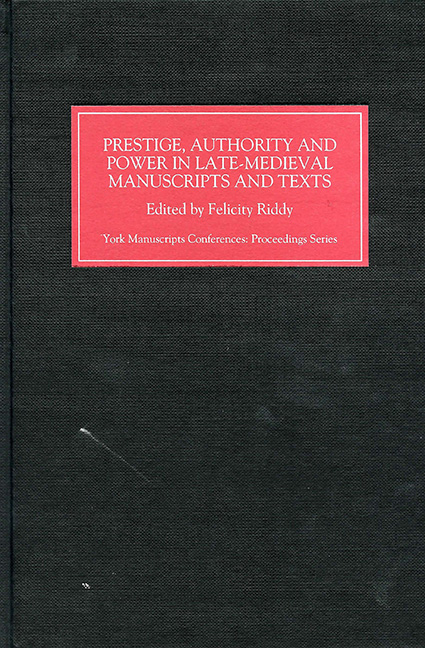Book contents
- Frontmatter
- Contents
- List of Plates
- Introduction
- Inventing Authority: Glossing, Literacy and the Classical Text
- Manuscripts of Nicholas Love's The Mirror of the Blessed Life of Jesus Christ and Wycliffite Notions of ‘Authority’
- The Patronage and Dating of Longleat House MS 24, a Prestige Copy of the Pupilla Oculi Illuminated by the Master of the Troilus Frontispiece
- Limner-Power: A Book Artist in England c. 1420
- A Poet's Contacts with the Great and the Good: Further Consideration of Thomas Hoccleve's Texts and Manuscripts
- The Politics of Book Ownership: The Hopton Family and Bodleian Library, Digby MS 185
- Piety, Politics and Persona: MS Harley MS 4012 and Anne Harling
- The Abbess of Malling's Gift Manuscript (1520)
- ‘Plutarch's’ Life of Agesilaus: A Recently Located New Year's Gift to Thomas Cromwell by Henry Parker, Lord Morley
- Manuscripts after Printing: Affinity, Dissent and Display in the Texts of Wyatt's Psalms
- Index of manuscripts
- Index of names and titles
- York Medieval Press: Publications
Limner-Power: A Book Artist in England c. 1420
Published online by Cambridge University Press: 24 October 2017
- Frontmatter
- Contents
- List of Plates
- Introduction
- Inventing Authority: Glossing, Literacy and the Classical Text
- Manuscripts of Nicholas Love's The Mirror of the Blessed Life of Jesus Christ and Wycliffite Notions of ‘Authority’
- The Patronage and Dating of Longleat House MS 24, a Prestige Copy of the Pupilla Oculi Illuminated by the Master of the Troilus Frontispiece
- Limner-Power: A Book Artist in England c. 1420
- A Poet's Contacts with the Great and the Good: Further Consideration of Thomas Hoccleve's Texts and Manuscripts
- The Politics of Book Ownership: The Hopton Family and Bodleian Library, Digby MS 185
- Piety, Politics and Persona: MS Harley MS 4012 and Anne Harling
- The Abbess of Malling's Gift Manuscript (1520)
- ‘Plutarch's’ Life of Agesilaus: A Recently Located New Year's Gift to Thomas Cromwell by Henry Parker, Lord Morley
- Manuscripts after Printing: Affinity, Dissent and Display in the Texts of Wyatt's Psalms
- Index of manuscripts
- Index of names and titles
- York Medieval Press: Publications
Summary
If we surmise that a limner might obtain ascendancy in the fifteenth century, the quality of his work was almost certainly his main entrée to the corridors of power and to the patrons who walked those tiled floors. The limners' guild seems not to have been a considerable presence nor to have had much influence on city affairs, even if its members must have possessed a talent not available to ambition or to purchase. A youth might have learned the skill to be a draper but not the talent of a limner, and this talent is of course a special form of power. Once an individual artist was admitted – at whatever remove – to the employment of dukes, bishops, and abbots, he could, if exceptional, apparently exact at least one useful privilege – that of a reduced limning load. That he could also be more selective among prospective customers is another possible if perhaps less provable hypothesis. The artist whom I intend to discuss in this paper as representative of limner–power is already widely appreciated: he is the master of the frontispiece of Cambridge, Corpus Christi College, MS 61, the justly famous copy of Chaucer's Troilus and Criseyde. I shall suggest here four further manuscripts – and two other possible manuscripts – that were either illustrated or decorated (or both) by this illuminator, demonstrate his usual procedure in completing work on each manuscript, and point to a consistency in the type of patron for whom he worked, both as of interest in itself and as a possible indication of his capacity to select among patrons.
The master of the Corpus frontispiece (Plate 8) was an exceptional painter whose style was strongly influenced by Parisian book illustration. The Corpus Master's work might be described as ‘International French’, or, probably an English artist, he may have been trained either on the Continent or by a French artist in England, who had absorbed some aspects of English book illustration, notably the border design. As we shall see, this French connection may prove important with respect to the standing figure whom the author/speaker in the pulpit seems to address. As far as the date of the frontispiece is concerned, Salter stated that, on grounds of costume, the Corpus miniature could not refer to ‘a period later than the second decade of the fifteenth century’.
- Type
- Chapter
- Information
- Publisher: Boydell & BrewerPrint publication year: 2000

